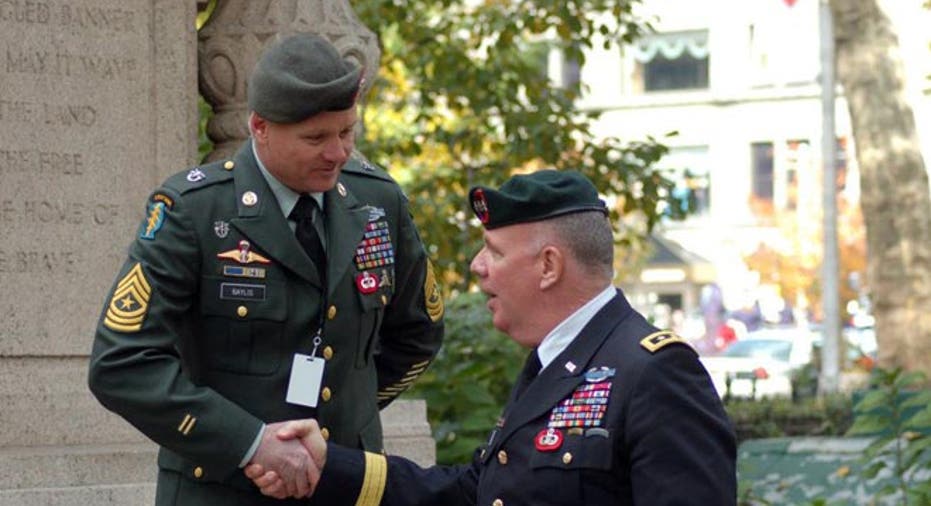How One Decorated Vet Is Giving Back With ‘Paul’s House’

It is amazing how some go above and beyond when trying to give to their country. Be it contributions to charitable causes, volunteering your time to help others or fighting for your country, some shine above the rest.
Meet Mark Baylis, U.S. Army Special Forces veteran and co-founder of The Major Paul Syverson Veterans Sanctuary also known as “Paul’s House” which serves as a transition home for homeless veterans. The facility is named after a decorated Army officer from Illinois who was killed in Iraq in 2004.
Mr. Baylis found some time to speak with FOXBusiness.com regarding his past, and how Paul’s House is faring.
Q: Can you elaborate on why you joined the military, what you did, where you served, time of service?
A: I joined the U.S. Army to be an infantry Paratrooper in the 82d Airborne division the day they swore Ronald Reagan in to be president. The Iranians were still holding our embassy and staff hostage, so I wanted to go serve my part in their repatriation. On the way home from enlisting, I learned the Iranians let the hostages go, but I still decided to make the best of it. Shortly after my arrival in the 82d, I volunteered for the Rangers, where I successfully completed Ranger training and was awarded my Ranger tab in 1982. I volunteered for Special Forces training in 1983 and completed the qualification Course in 1984 as a weapons Sergeant. I went on to serve in Special Forces assignments, was injured in the line of duty in Baghdad in 2003, and then was was medically retired as an E9 Sergeant Major in April 2007.
Q: Did any of your family or friends serve as well?
A: My father served 2 years in the army. My maternal grandfather, who I was named after, was killed in the last B-29 shot down in the Pacific. The sole survivor married his widow and raised my mother as his own. But he suffered tremendous survivors guilt. And he committed suicide a day or two from the shoot down anniversary; the first one after his son graduated college and was ready to be on his own.
Q: How did you get involved in Paul’s House and your other endeavors?
A: When transitioning to civilian life as an injured Veteran, I was asked by a Veterans group called the Slate Belt Veterans (SBV) to help them research community Veterans needs so they could give input to a new VA facility coming to their area. The insights I gained were alarming.
But the “Readers Digest” version is the process was flawed. It was frustrating for me getting billed for prescriptions for injuries received in combat. So in 2008, I started studying the process. With what I learned, I resubmitted my claim paperwork and it went through quickly and no further billing occurred.
As I traveled around the community I heard many stories of Veterans in the same situation, so I started helping them with their claim paperwork. Importantly, in the food pantry line, most of the males over 30 were Veterans, and as I got to know them I learned many weren’t working due to the effects of service-related health conditions. I started helping them and soon word spread and people started calling me for help. An alarming pattern jumped out at me. Every time I did paperwork for an unemployed or homeless Veteran it included a mental health entry.
My interaction with the Slate Belt Veterans ultimately didn’t work out as planned, but the issues uncovered were too important to ignore, so I took it upon myself. These things take time without a large sponsor, but we received our 501 © 3 designation from the IRS (which allows for federal tax exemption of nonprofit organizations) in January 2012 and the organization is named VALOR (Veterans Assisted Living Out Reach).
We immediately started doing outreach events and researched a PTSD (Post Traumatic Stress Disorder) approach. We managed to help 89 Veterans that year, and the number rose to about 160 in 2013, and about 400 in 2014.
Our PTSD program, Veterans Unstoppable, was established in 2014 and we opened Paul’s House our first homeless Veteran recovery center in October of that year. A second facility in Ohio was also donated to us by a Vietnam Veteran and his wife and renovations are ongoing. Importantly, our staff is made up entirely of volunteers, with the exception of our 1 employee who is the facility site manager at Paul’s House.
Veterans Organizations Per Capita By State | FindTheHome!function(d,s,id){var js,fjs=d.getElementsByTagName(s)[0],p=/^https:/.test(d.location)?'https':'http';if(!d.getElementById(id)){js=d.createElement(s);js.id=id;js.src=p+"://cdn1.findthebest.com/rx/widgets.js";fjs.parentNode.insertBefore(js,fjs);}}(document,"script","ftb-widgetjs");
Q: Paul’s House has been in operation for nearly a year, how are things going at the center?
A: Things are going very well overall. Our site manager has created a good climate where the guys feel at home and safe. Those are big challenges at other shelters. Our occupancy floats as we have Vets graduate the program or fail out. It seems to stay between 60%-80%. In the winter, it is closer to 91%. Our biggest lesson learned has been the health challenges these guys face. We had been in dire need of a transportation vehicle to take them to medical appointments, but we thankfully received official word on June 24 a van has been donated from an emergency service in the Pocono area to help us help our Veterans.